Designing Your Dream Mid-Century Modern Kitchen: The Ultimate Style Guide
A mid-century modern kitchen represents more than just a passing trend; it embodies a timeless design philosophy that merges sleek aesthetics with unparalleled functionality. Imagine a space that feels open, inviting, and effortlessly chic – that’s the essence of this beloved style. With its characteristic clean lines, thoughtful layouts, and a harmonious blend of natural and engineered materials, a mid-century modern kitchen perfectly balances beauty and practicality, creating a hub that’s both a joy to cook in and a pleasure to entertain within.
In this comprehensive guide, we will delve deep into the essential elements that define mid-century modern kitchens. From understanding iconic design principles and exploring inspiring layout ideas to discovering sustainable material choices and overcoming common renovation challenges, you’ll find everything you need. Whether you’re embarking on a full-scale renovation project or simply looking to infuse some vintage charm into your existing space, prepare to unlock valuable tips on budgeting, expert styling techniques, and clever solutions to bring your dream kitchen to life.
Mid-Century Modern Kitchen: Essential Design Elements
The allure of a mid-century modern kitchen lies in its distinctive design language. To truly capture this aesthetic, focusing on key elements is crucial:
- Sleek Cabinetry: The foundation of any mid-century modern kitchen is its cabinetry. Expect to see predominantly flat-front cabinetry, often referred to as slab or European style. These doors lack ornate details, allowing the natural beauty of the wood or chosen finish to shine. Iconic woods like teak, walnut, or rosewood are highly prized for their rich grains and warm tones, instantly adding a sense of sophistication. For those working with a tighter budget, alternatives like oak offer a similar classic appeal, while high-quality wood-look laminates can replicate the desired aesthetic with impressive fidelity and durability.
- Hardware with Character: Complementing the minimalist cabinetry, geometric cabinet hardware in materials like brass or chrome adds a subtle touch of mid-century flair without overwhelming the clean lines. Think simple, elegant pulls or knobs that echo the era’s appreciation for understated design.
- Thoughtful Color Palettes: The color scheme in a mid-century modern kitchen typically features a soothing base of warm whites, soft grays, and earthy tones such as olive green, mustard yellow, and even subtle shades of burnt orange. These colors create a calming and natural backdrop. To prevent the space from feeling too muted, introduce bold accents sparingly with hues like coral, teal, or deep blue. These pops of color should be used strategically – perhaps on a single wall, in bar stools, or through decorative accessories – to maintain visual balance and prevent a cluttered feel.
- Natural Material Pairings: Warmth is essential, often introduced through abundant wood accents. This can include anything from functional teak cutting boards and elegant walnut shelving to wooden furniture pieces. To create visual contrast and prevent the space from feeling too heavy, countertops are frequently selected in lighter, refined materials such as light quartz or distinctive terrazzo. These choices offer durability and a smooth, easy-to-clean surface that brightens the room.
- Iconic Lighting: Lighting in a mid-century kitchen serves both practical and aesthetic purposes. Natural and geometric pendant fixtures or wall sconces are common, designed to maintain an airy, open atmosphere. Look for pieces with sculptural qualities, often made from brass, chrome, or even frosted glass, that become focal points while providing ample illumination.
- Efficient and Open Layouts: Above all, mid-century modern kitchens prioritize efficiency and openness. Layouts are designed to be highly functional, integrating distinct working zones while maximizing space without a hint of clutter. This often translates to open-concept designs that seamlessly connect the kitchen to dining and living areas, fostering a sense of flow and spaciousness.
Mid-Century Modern Kitchen Design Inspirations
Mid-century modern kitchens are renowned for their clean lines, highly functional layouts, and the thoughtful use of natural materials. Here are some inspiring ideas to help you envision and design your own unique space:
1. Classic Wood Tones & Balanced Colors
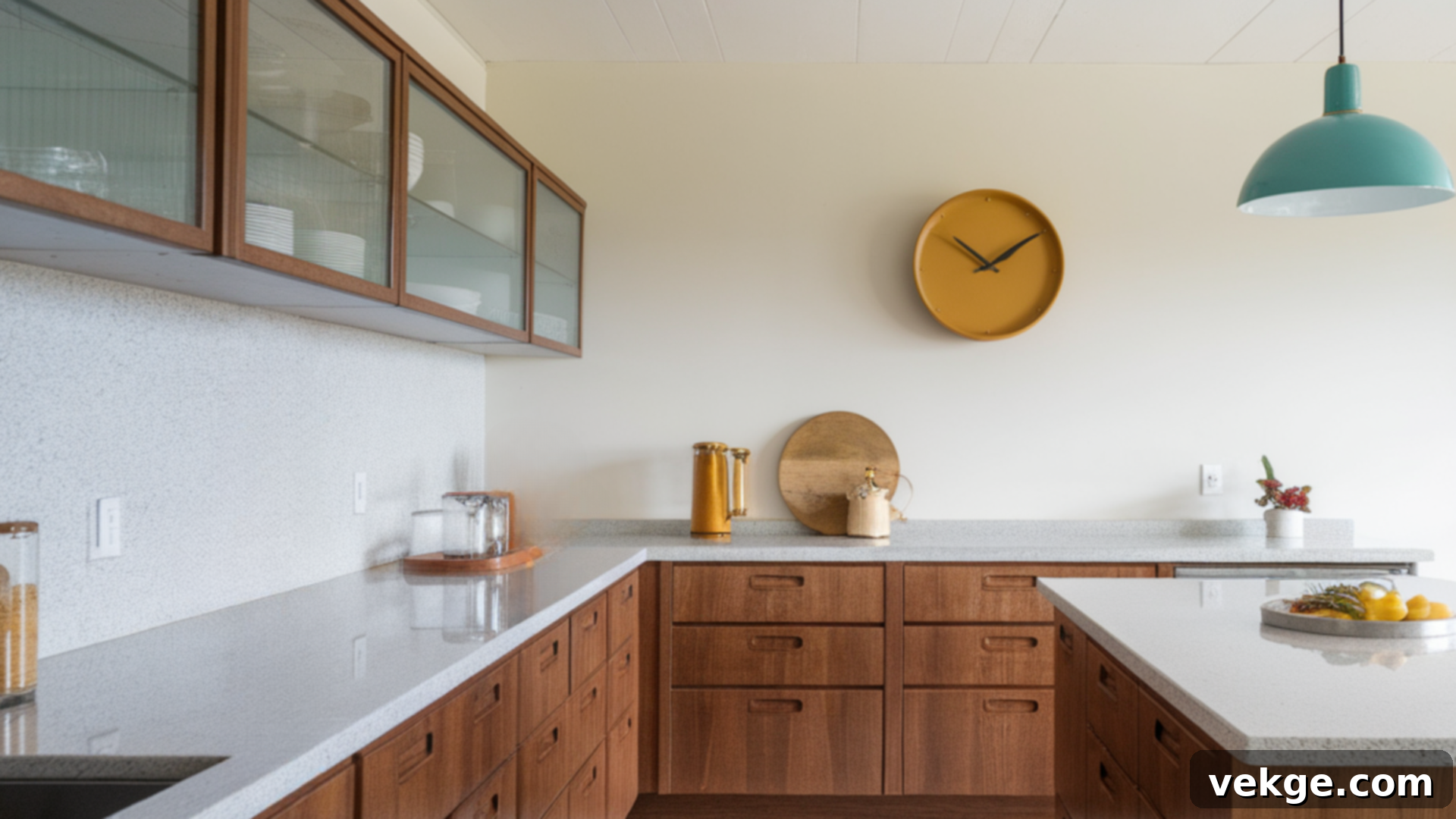
Embrace the warmth of nature by pairing rich walnut or elegant teak cabinetry with light, durable quartz or rustic butcher block countertops. The contrast creates visual interest while maintaining a sophisticated foundation. Introduce subtle, yet impactful, bold hues like mustard yellow, deep olive, or vibrant turquoise in small accents – perhaps through bar stools, a vintage rug, or decorative ceramics – to complement the natural wood tones without overwhelming the serene ambiance of the space. This careful balance ensures a design that is both lively and harmonious.
2. Geometric Touches & Display Storage
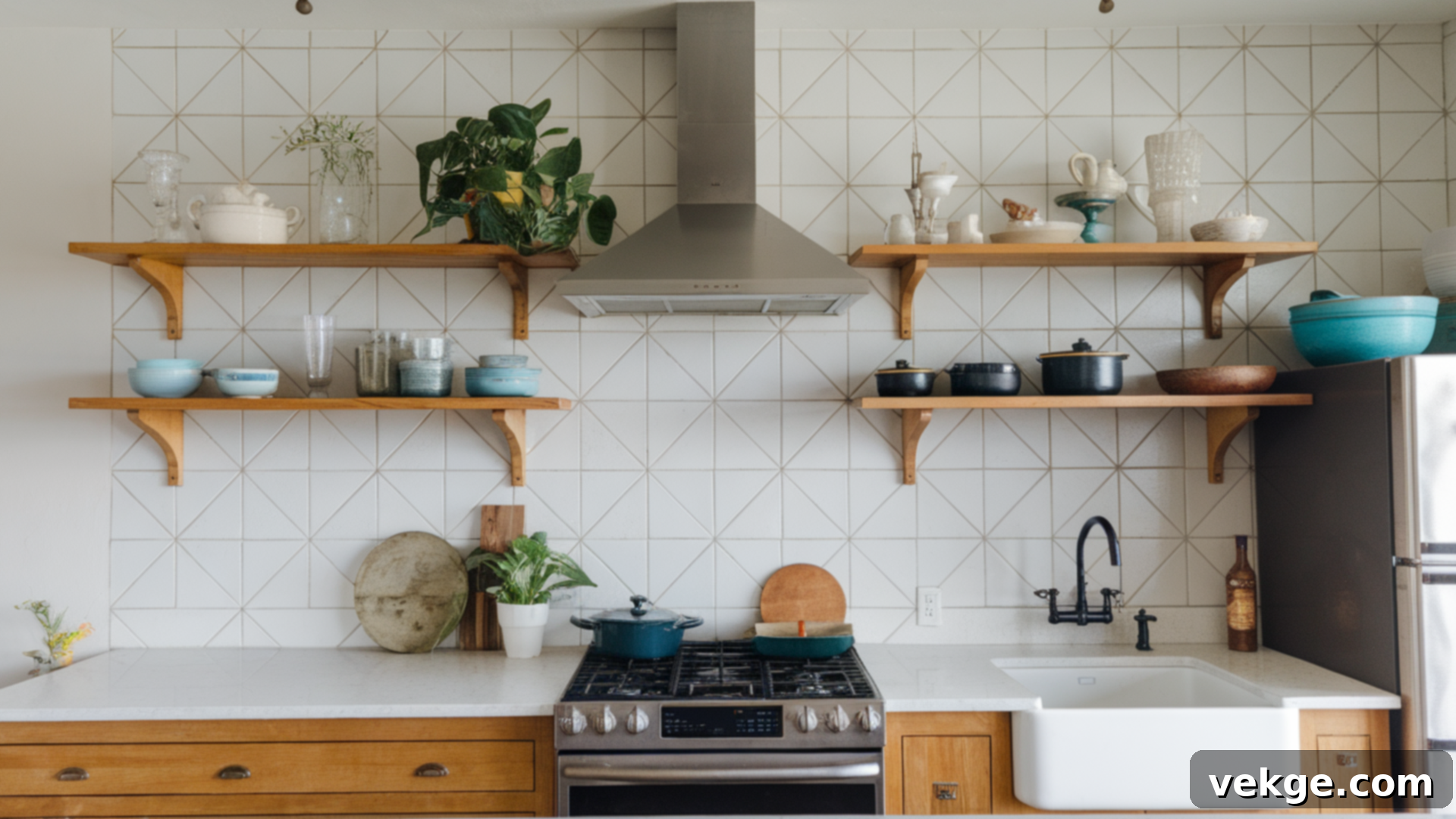
Infuse a sense of playful sophistication by incorporating geometric tile backsplashes, a hallmark of mid-century design. Consider patterns like hexagons, diamonds, or simple linear designs in muted or contrasting colors. Pair these with open or floating shelving units, crafted from the same iconic woods as your cabinetry. These shelves offer both stylish display opportunities and practical storage, allowing you to elegantly showcase vintage glassware, a collection of unique ceramic bowls, vibrant plants, or your most cherished cookware. This approach adds character and depth while maintaining the open, airy feel characteristic of the era.
3. Light and Layout
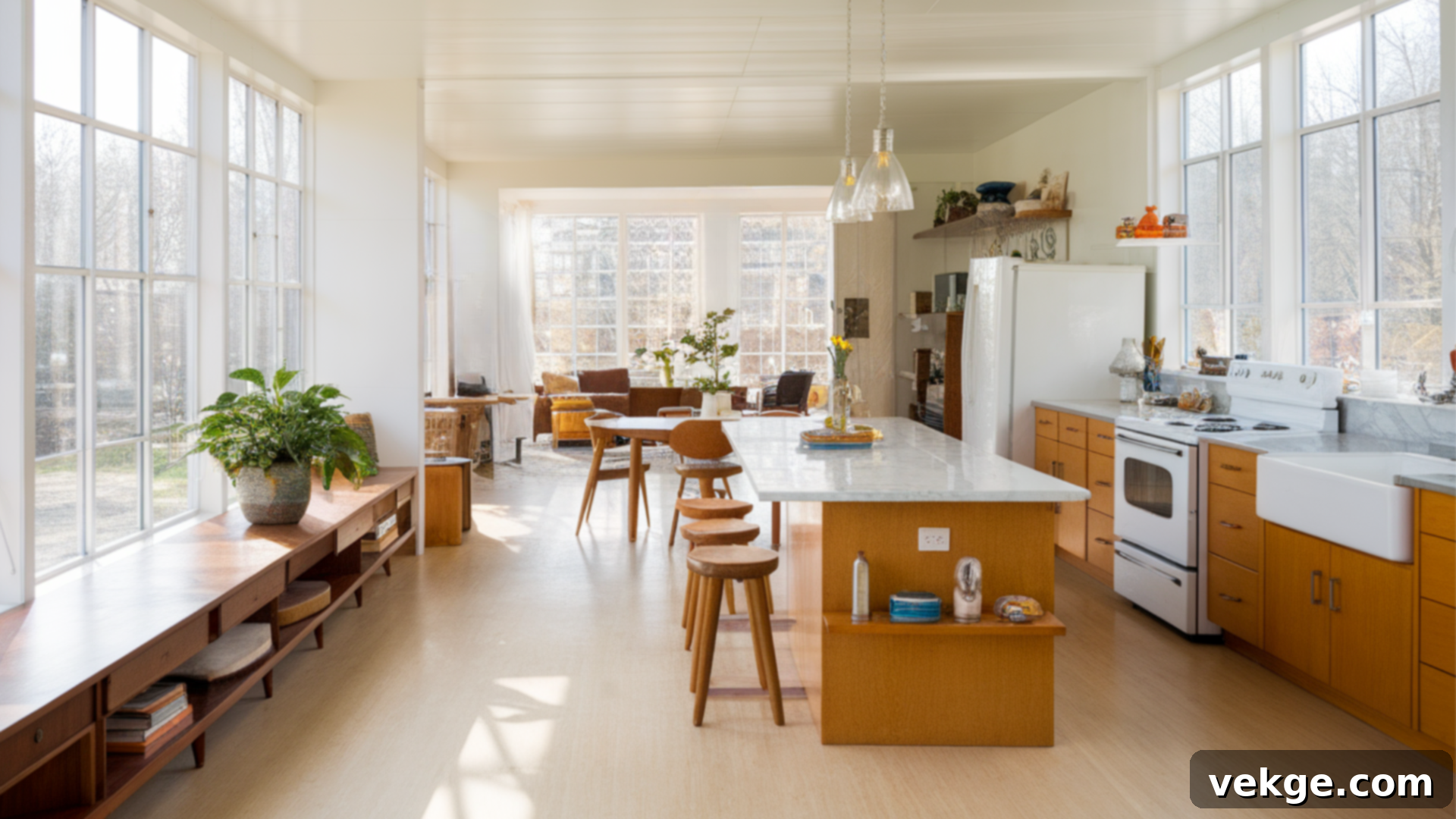
A cornerstone of mid-century modern design is the connection to the outdoors and an abundance of natural light. Maximize this by incorporating large windows, expansive glass doors, or even strategically placed skylights to flood your kitchen with sunshine. Complement this natural brightness by maintaining an open-concept layout, ensuring a seamless flow between the kitchen, dining, and living areas. This classic principle not only enhances the sense of space and airiness but also promotes interaction and a relaxed atmosphere, creating a kitchen that feels bright, welcoming, and perfectly integrated into your home’s overall design.
4. Multifunctional Islands & Minimalist Appliances
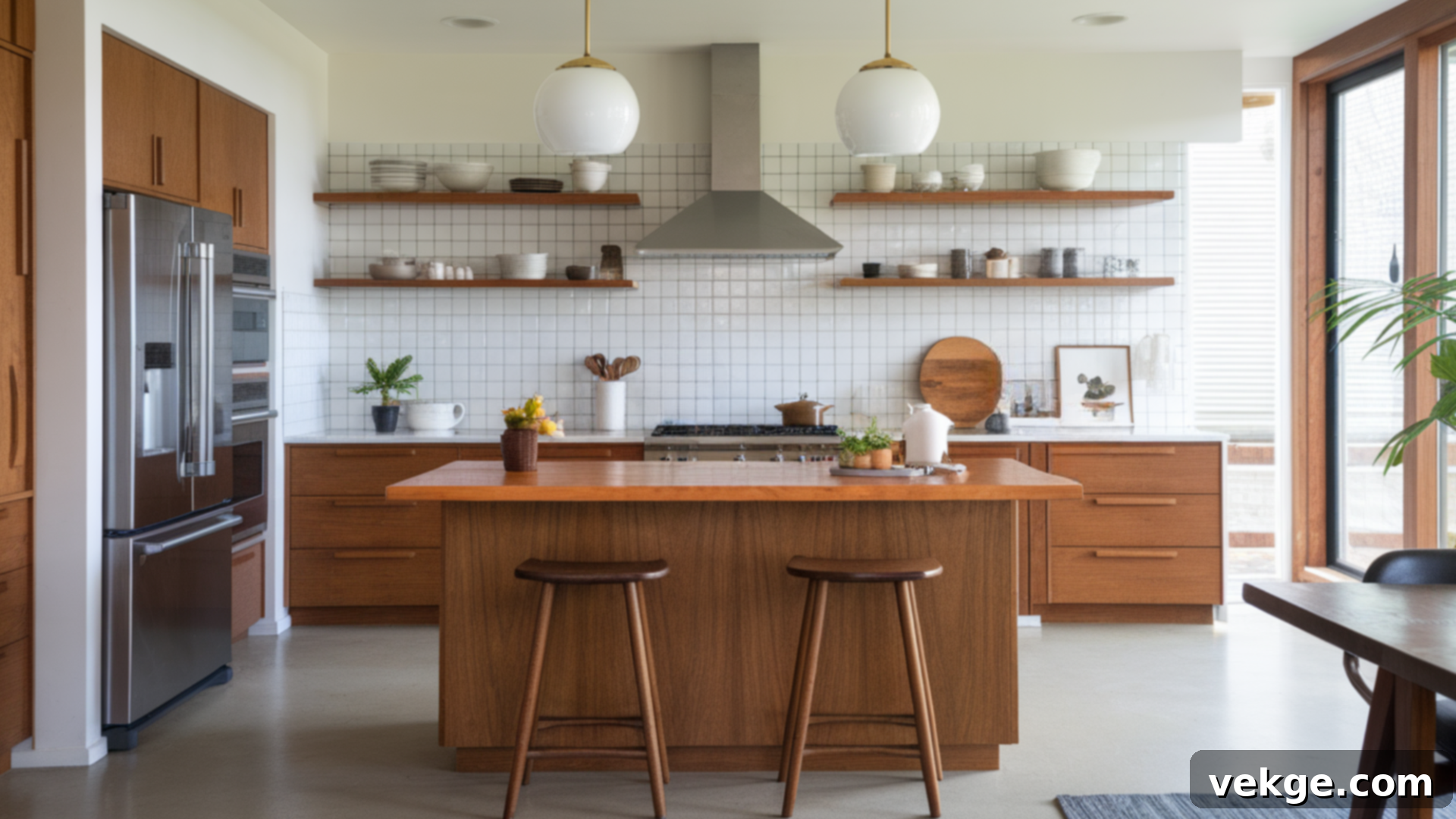
Incorporate a central island that serves multiple purposes, such as a prep station, a casual dining area, and additional storage. A wood-topped island can provide warmth and a natural focal point. When it comes to appliances, opt for panel-ready options that blend seamlessly with your cabinetry, creating a cohesive and uncluttered look. Alternatively, select retro-inspired appliances that offer modern efficiency within a nostalgic package. This combination thoughtfully marries the timeless appeal of mid-century design with the practical demands of contemporary living, ensuring your kitchen is both beautiful and highly functional.
5. Lighting with Character

Elevate your kitchen’s style by choosing lighting fixtures that act as sculptural art pieces. Iconic options like Sputnik chandeliers or elegant geometric pendant lights, often crafted from brass or chrome, are perfect for making a statement. These fixtures not only provide essential illumination but also infuse the space with a distinct mid-century character and a bold, artistic touch. Consider their placement carefully – over an island, dining table, or in a prominent corner – to maximize their visual impact and create a captivating focal point.
6. Vintage Accessories
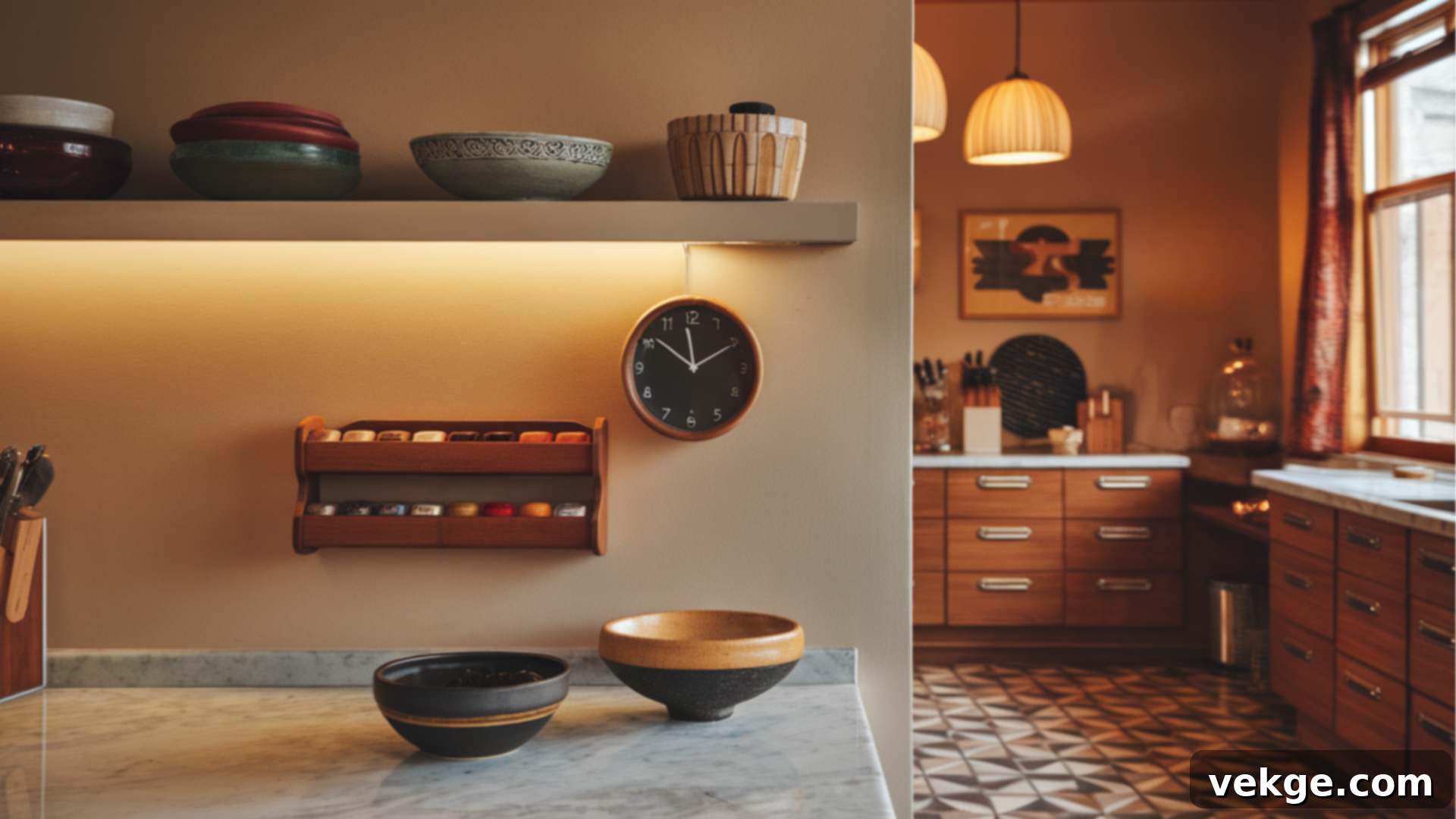
Authenticity is key to a truly captivating mid-century modern kitchen. Curate your space with genuine mid-century accessories found at antique shops, flea markets, or online vintage stores. Think ceramic bowls in bold, abstract patterns, iconic retro clocks, stylish teak spice racks, or unique glass carafes. These functional yet highly stylish items effortlessly infuse warmth, personality, and a delightful touch of nostalgia, significantly enhancing the overall mid-century feel and creating a space that tells a story.
7. Textured Materials
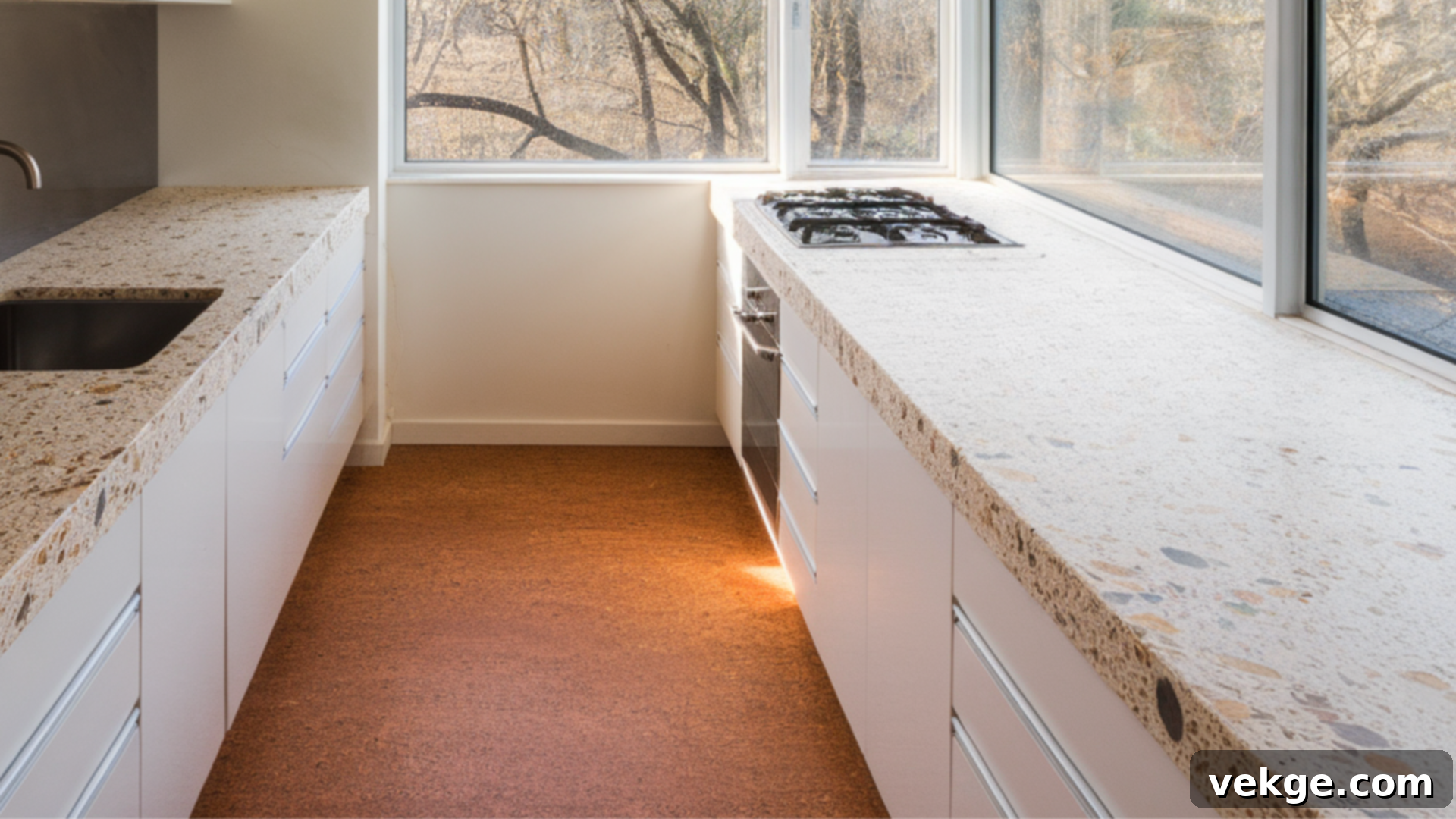
While mid-century modern design often emphasizes simplicity, incorporating varied textures adds essential depth and visual interest without clutter. Consider materials like terrazzo for countertops or cork for flooring. Terrazzo, with its speckled appearance and durable surface, offers a playful yet sophisticated touch. Cork, known for its sustainable properties and natural warmth, provides a soft underfoot feel and excellent acoustic properties. These materials help maintain the clean lines and minimalist ethos of the design while offering a unique tactile and visual experience, which is a key hallmark of the mid-century style.
8. Greenery and Natural Elements

A strong connection to nature is inherent in mid-century modern design. Bring life and freshness into your kitchen by integrating lush plants and other natural elements. Consider a variety of indoor plants in stylish ceramic planters, a bowl of fresh fruit as a centerpiece, or even carefully selected botanical prints. Greenery not only purifies the air and adds a vibrant splash of color but also reinforces the organic and serene aspect of the mid-century aesthetic, creating a truly inviting and refreshing atmosphere within your culinary space.
9. Open Layouts
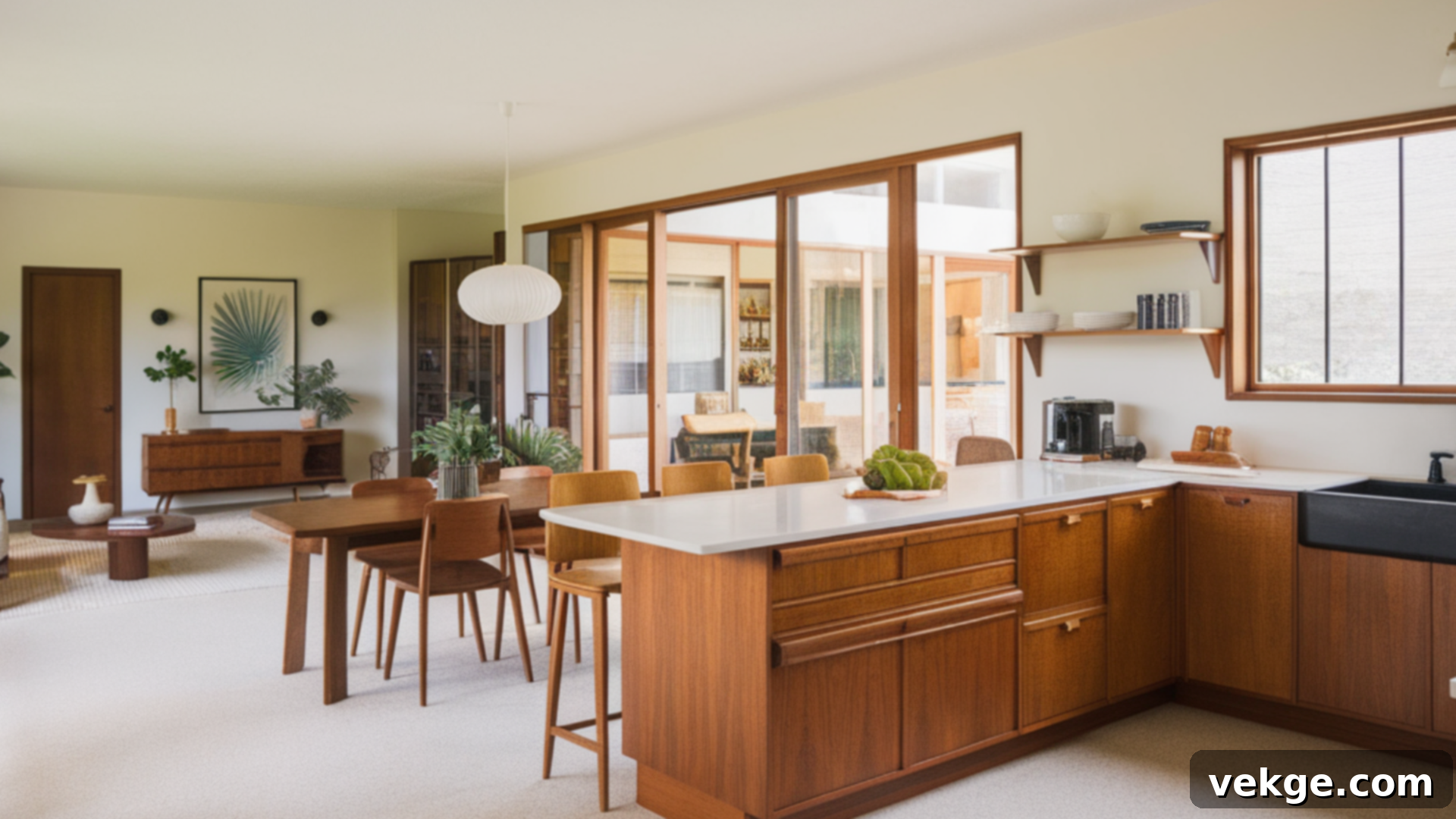
The hallmark of a truly mid-century modern home is often its open-concept design, and the kitchen is no exception. Design your kitchen to flow effortlessly into adjacent living and dining areas, breaking down traditional barriers. This free-flowing layout creates a sense of expanded space, encourages social interaction, and is perfect for both everyday living and entertaining guests. It emphasizes connectivity and functionality, embodying the era’s forward-thinking approach to domestic architecture and offering a versatile space ideal for modern lifestyles.
10. Bold Color Accents
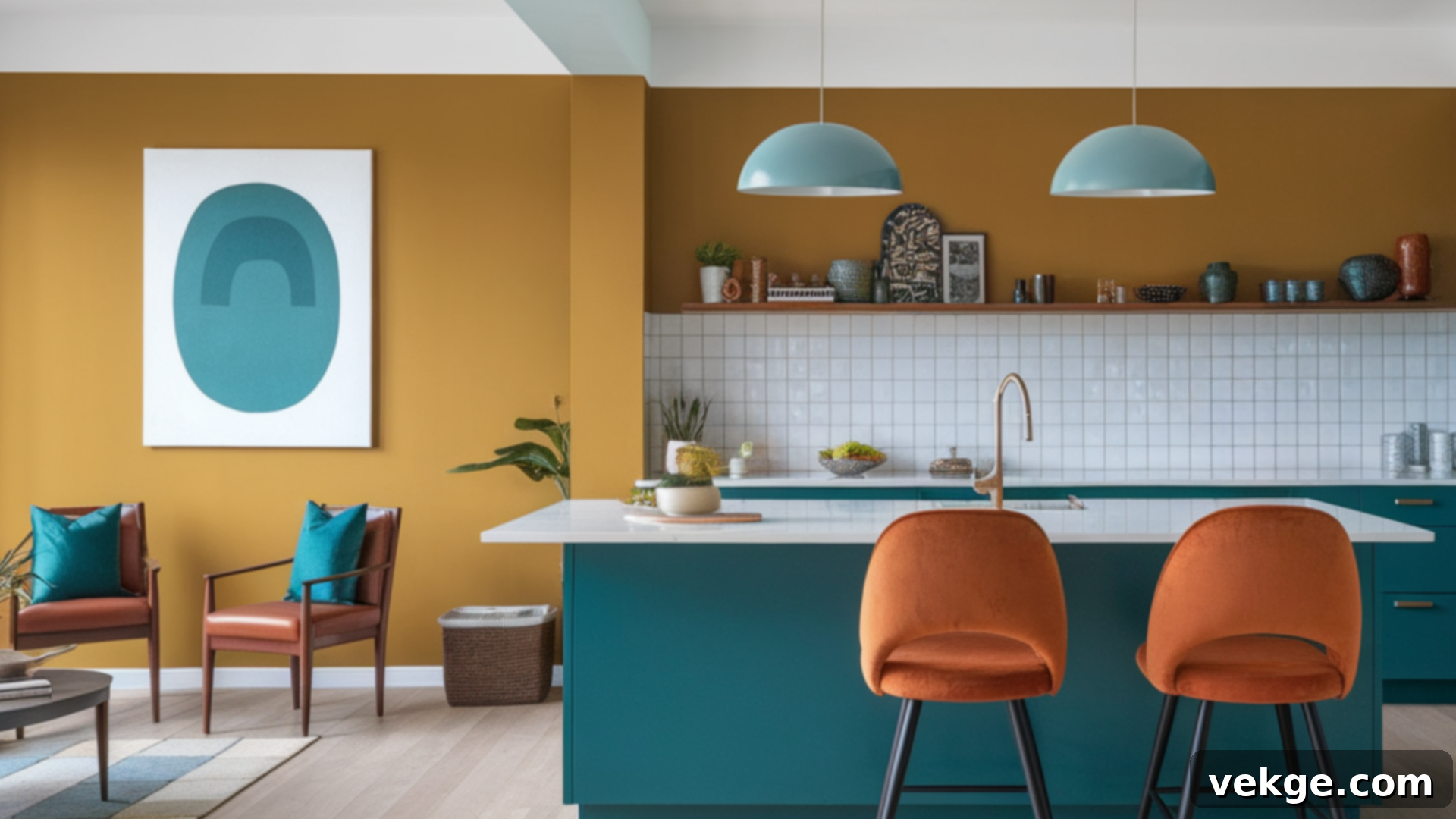
While natural tones form the base, mid-century design often revels in vibrant splashes of color. Introduce energizing hues like teal, mustard yellow, burnt orange, or avocado green through carefully selected accessories. This could include a piece of striking artwork, plush pillows on a banquette, statement dining chairs, or even a brightly colored vintage appliance. These bold accents provide a dynamic contrast to the wood and neutral backdrops, infusing the space with personality and a playful energy that remains perfectly in harmony with the overall mid-century modern style.
11. Floating Shelves
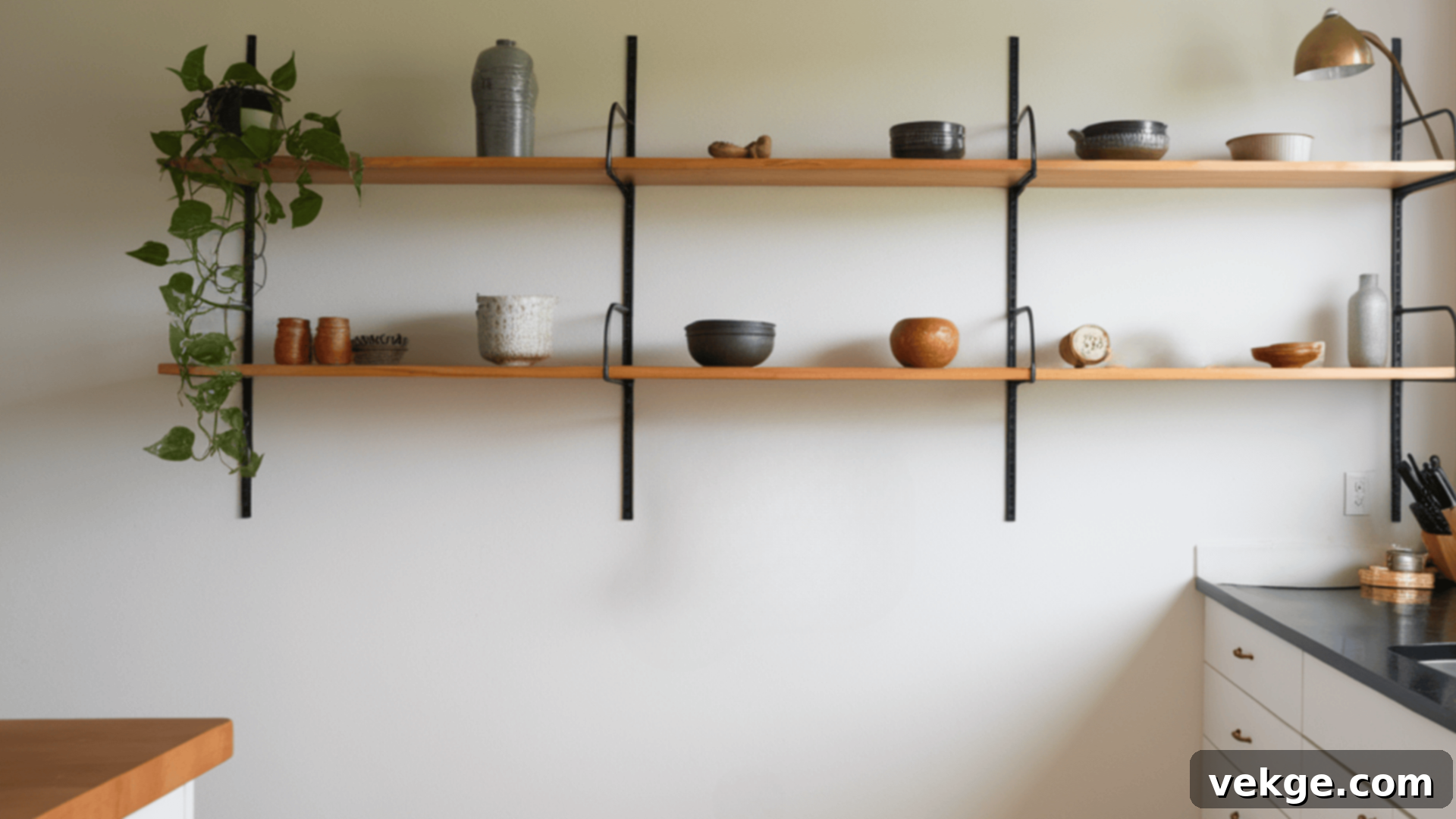
Embrace minimalist storage solutions by installing sleek floating shelves. These wall-mounted shelves appear to float effortlessly, maintaining the open and airy feel that is characteristic of mid-century design. They are perfect for displaying a curated collection of decorative items, unique serving ware, your favorite cookbooks, or frequently used essential kitchenware. This design choice not only adds a sophisticated touch but also offers convenient, stylish storage that enhances the modern aesthetic while keeping your kitchen clutter-free and visually appealing.
12. Retro Appliances with Modern Touches
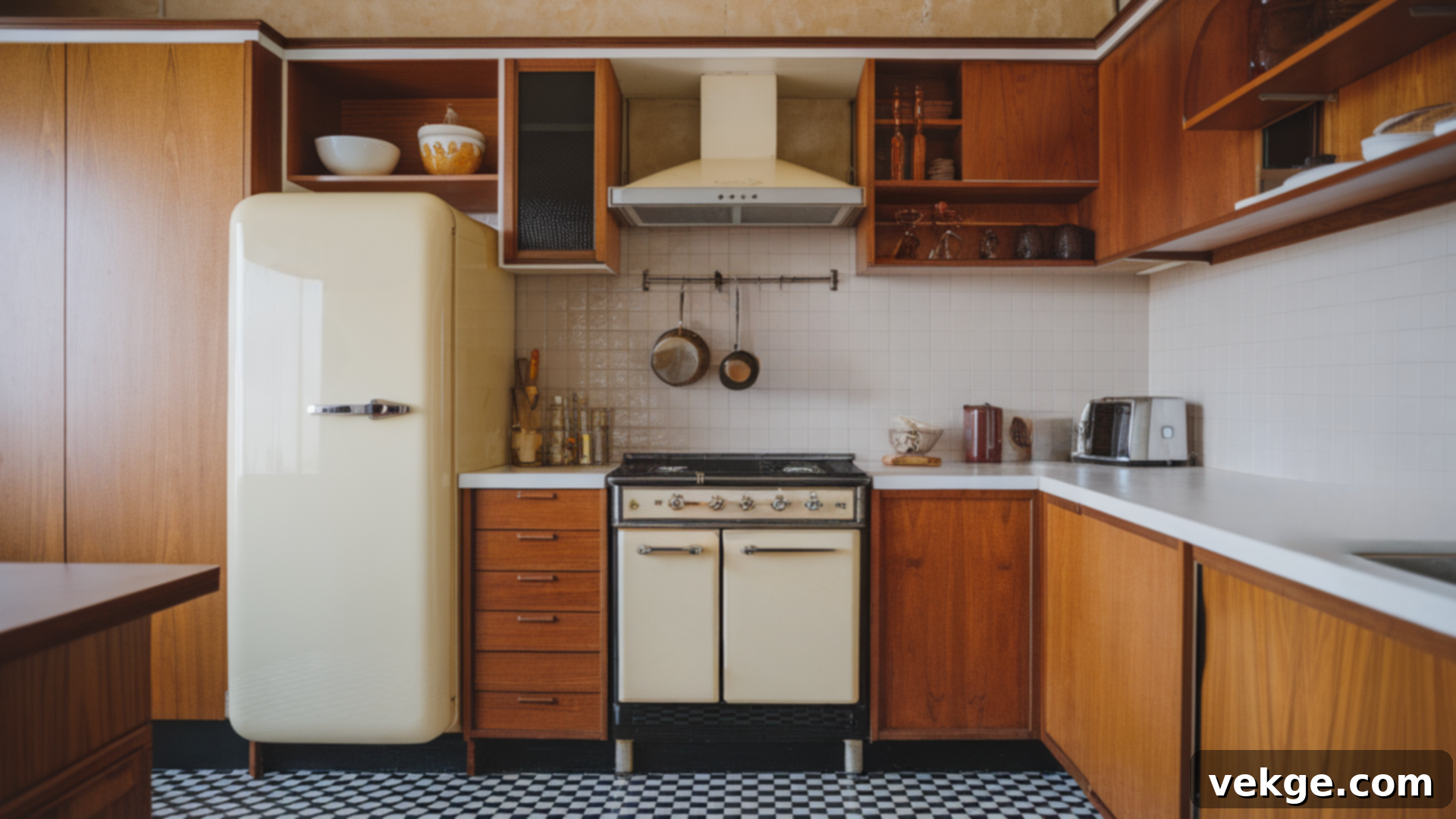
Achieve a perfectly balanced look by blending the charm of retro-style appliances with the cutting-edge technology of today. Imagine a beautifully designed refrigerator with a vintage aesthetic that secretly boasts energy-efficient features and smart capabilities, or a sleek, classic-looking oven with advanced cooking functions. This approach allows you to enjoy the nostalgic appeal of mid-century design without sacrificing the practical benefits and convenience of contemporary efficiency. These appliances become both functional tools and conversation-starting design statements.
13. Natural Stone Countertops
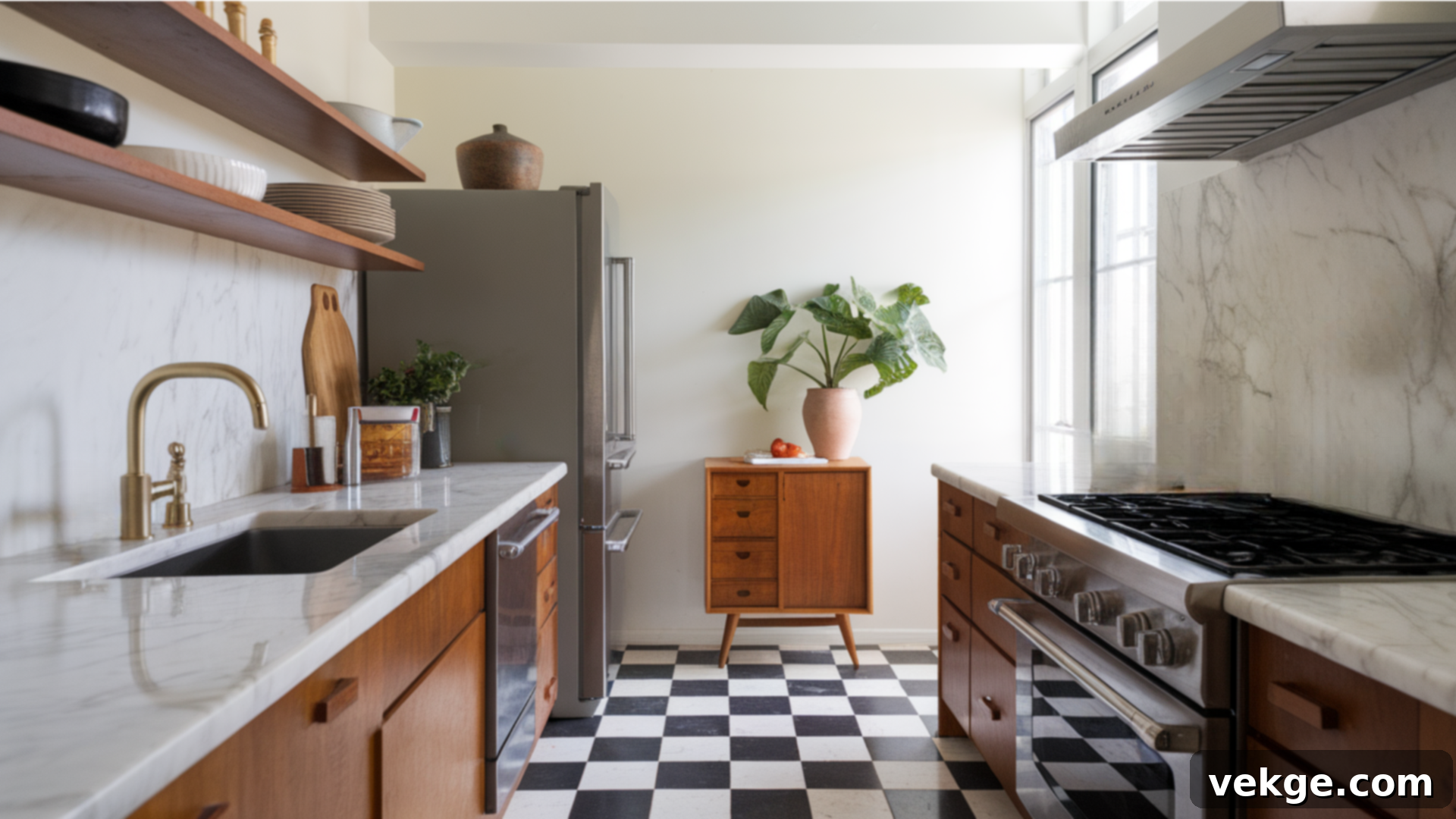
Elevate the sophistication of your mid-century kitchen by selecting natural stone for your countertops. Materials like marble, granite, or soapstone offer unparalleled durability and a timeless aesthetic that perfectly aligns with the principles of mid-century modern design. The unique veining and subtle variations in natural stone add an organic touch that complements wood cabinetry beautifully. These surfaces are not only incredibly resilient and practical for daily kitchen tasks but also infuse your space with a luxurious and enduring beauty, ensuring both high functionality and captivating design.
14. Integrated Storage Solutions
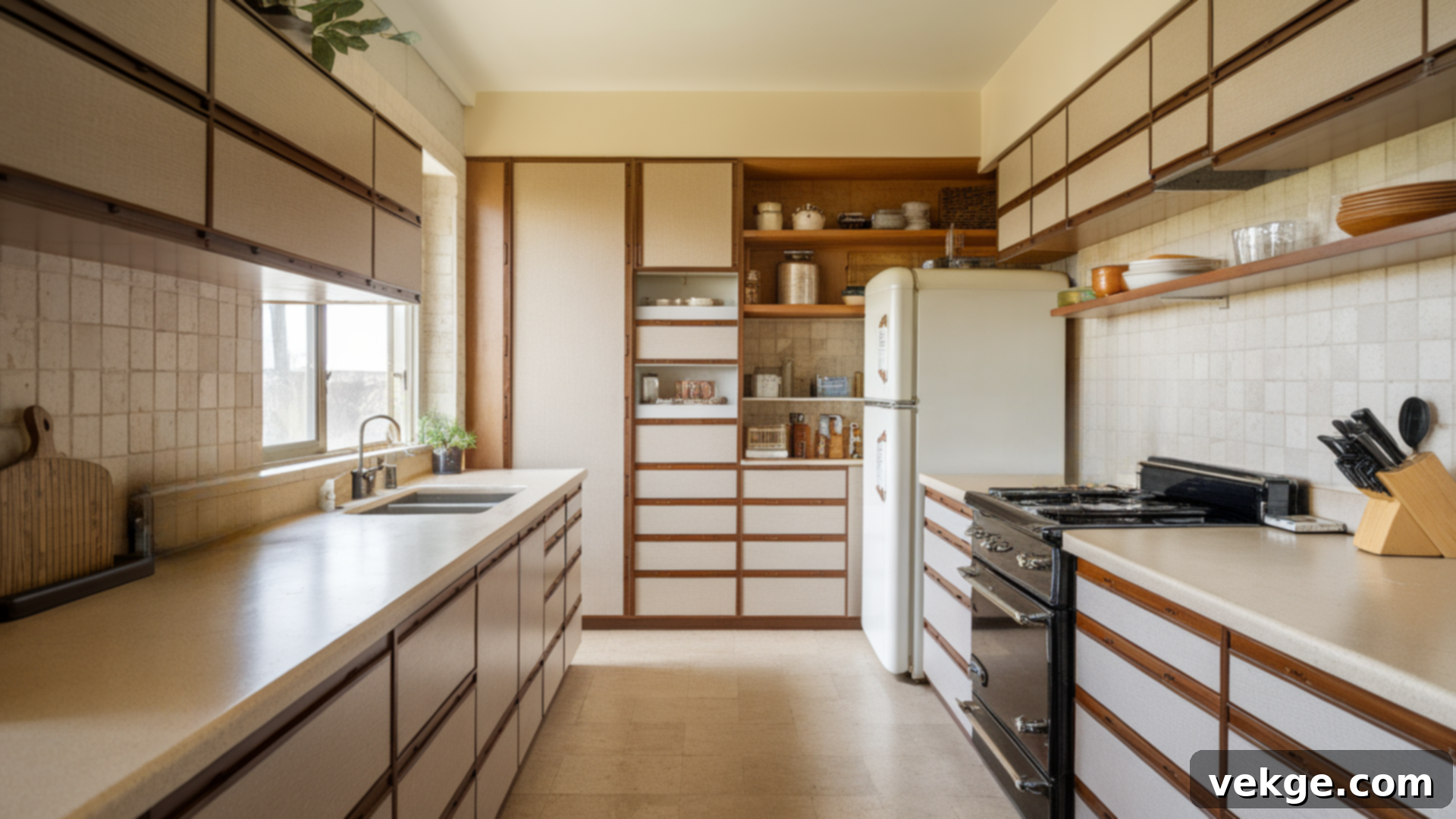
A hallmark of mid-century modern efficiency is a commitment to seamless, concealed storage. Utilize built-in cabinets, cleverly designed drawers, and pantry systems that perfectly blend into the kitchen’s architecture. This approach ensures that clutter is kept out of sight, maintaining the sleek, streamlined appearance that defines the style. Integrated storage solutions are essential for preserving the minimalist, organized feel of a mid-century modern kitchen, ensuring every item has its place and the focus remains on the clean lines and beautiful materials.
These diverse ideas beautifully combine mid-century style with modern functionality, creating a kitchen that is both timeless and eminently practical. Whether your space is small or large, these elements can be thoughtfully adapted to suit any architectural context, allowing for a personalized design that perfectly reflects your taste.
Essential Steps for Your Mid-Century Modern Kitchen Renovation
Embarking on a kitchen renovation can be a daunting but rewarding process. By following these essential steps, you can ensure a smooth transition and create a functional, stylish, and truly inspiring mid-century modern space:
Step 1: Define Your Vision
The first and most critical step is to clearly define your vision. Begin by creating mood boards, collecting images that inspire you, and understanding the specific elements of mid-century design that resonate most with your personal style. Collaborate closely with experienced architects and interior designers who specialize in this aesthetic. Focus on crafting a space that seamlessly blends iconic mid-century style with modern function, ensuring the design remains open, minimalist, and perfectly tailored to your lifestyle and taste. A well-articulated plan will serve as your guiding compass throughout the entire renovation process.
Step 2: Integrate Appliances Seamlessly
In mid-century modern kitchens, appliances should enhance, not detract from, the overall aesthetic. Select appliances with incredibly clean lines and a minimalist profile. Induction cooktops and sleek wall ovens are excellent choices for their modern efficiency and subtle presence. Crucially, opt for panel-ready refrigerators and dishwashers that can be faced with custom cabinetry panels, allowing them to disappear seamlessly into your kitchen’s design. Seek out models that cleverly offer both a touch of retro charm in their design and the latest energy-efficient features, ensuring a blend of style and sustainability.
Step 3: Durable, Stylish Flooring
The right flooring choice is vital for both durability and style. Install robust and timeless options like quarry tiles, known for their exceptional resilience to high traffic and spills. These tiles are inherently slip-resistant, remarkably easy to clean, and perfectly suited for the demands of a busy mid-century modern kitchen. Beyond their practical benefits, quarry tiles effectively capture the earthy, authentic look of the 1950s and 60s, offering a solution that is both visually appealing and incredibly long-lasting. Other excellent choices include cork, terrazzo, or even polished concrete.
Step 4: Maximize Space and Storage
Mid-century modern design celebrates open and uncluttered environments. To truly achieve this, consider opening up your kitchen by strategically removing non-load-bearing walls or expanding doorways to create a more airy and spacious feel. Maximize every inch of your kitchen with intelligently incorporated built-in storage solutions. This can include custom cabinetry designed to fit perfectly, innovative pull-out drawers, smart pantry systems, or even sliding doors that conceal smaller appliances. By doing so, you’ll maintain an organized and clutter-free space, significantly enhancing both the kitchen’s aesthetics and its overall functionality.
Step 5: Personalize with Purpose
While adhering to the minimalist principles of mid-century design, don’t shy away from injecting your personality. Add unique character through carefully selected accessories such as authentic vintage clocks, beautifully crafted ceramic dishware, or artfully arranged floating shelves holding meaningful items like travel souvenirs or family photos. The key is to curate rather than clutter. Aim to maintain a cohesive look not just within the kitchen but across all your connected living spaces, ensuring a harmonious and personalized home environment.
For a detailed visual insight into these renovation steps and more design tips, watch this video:
Planning Your Mid-Century Modern Kitchen: Budget, Layouts, and Timeline
Effective planning is crucial for any successful kitchen project. When it comes to a mid-century modern kitchen, budgeting and understanding project scope are particularly important:
- Budgeting for Your Dream Kitchen: The cost of creating a mid-century modern kitchen can vary significantly based on the project’s scale and your material choices.
- Basic Updates (typically $10,000 – $25,000): This level usually includes refreshing existing cabinetry with new doors or refinishing, updating hardware, installing a new backsplash, and upgrading lighting fixtures. It’s ideal for minor facelifts.
- Significant Renovations (typically $25,000 – $75,000): This involves more substantial changes, such as installing semi-custom cabinets, replacing all appliances with mid-range models, and upgrading to durable countertops like quartz or granite. It often includes minor layout adjustments.
- High-End Projects (typically $75,000+): These comprehensive renovations feature custom cabinetry meticulously crafted from premium woods, high-end professional-grade appliances (often panel-ready), and luxurious countertop materials like marble or exotic stone. Extensive structural changes or significant layout reconfigurations fall into this category.
- Optimizing Layouts for Different Kitchen Sizes:
- For Smaller Kitchens: To maximize space and create an illusion of openness, consider pairing lighter-colored upper cabinets with darker, grounding lower cabinets. Incorporating open shelving can also help lighten the visual load and provide stylish display areas. A well-designed island or peninsula can offer additional workspace and a casual dining spot without overwhelming the footprint.
- For Larger Kitchens: These spaces truly benefit from the open-concept designs characteristic of mid-century modern style. A spacious central island can become a multi-functional hub for cooking, dining, and entertaining. Ensure clear pathways and distinct zones for different activities to maintain efficiency and avoid a sprawling, disconnected feel.
- Renovation Timeline: A typical mid-century modern kitchen renovation can range from a few weeks for initial planning and design to several weeks (or even months for high-end projects) for demolition, installation, and completion.
- Planning & Design (2-4 weeks): This phase involves consultations, drawing up plans, and selecting materials.
- Demolition & Rough-ins (1-2 weeks): Removal of old elements and preparation for new electrical, plumbing.
- Cabinet & Countertop Installation (2-4 weeks): This can vary based on custom orders.
- Appliance & Fixture Installation (1-2 weeks): Connecting utilities and final touches.
- Finishing Touches (1 week): Painting, backsplash, decorative elements.
While some minor DIY tasks, like painting or hardware installation, are manageable, complex changes, especially those involving plumbing, electrical work, or structural modifications, absolutely require professional help to ensure safety and quality.
Mid-Century Kitchen Design Challenges & Solutions
While creating a mid-century modern kitchen is incredibly rewarding, designers and homeowners can encounter specific challenges. Here’s how to navigate them:
- Poor Workflow or Cramped Spaces: Original mid-century homes might have less optimized layouts. This can be resolved by re-evaluating the “kitchen triangle” (sink, stove, refrigerator) and adjusting the placement or size of islands to improve flow. Consider removing non-load-bearing walls to open up the space.
- Storage Issues with Open Shelving: While open shelving is characteristic, it can lead to clutter if not managed well. Supplement open shelves with discreet floor-to-ceiling cabinets or highly efficient pull-out drawers for items you don’t want on display. Hidden pantries can also be a game-changer.
- Overdoing Retro Elements: It’s easy to cross the line from stylish to theme-park kitsch. To avoid this, follow the 80/20 rule: aim for 80% timeless, classic mid-century design principles (clean lines, natural materials) and only 20% bold, iconic retro touches (a Sputnik light, a specific bold color appliance). Maintaining consistent wood tones and metal finishes throughout the space helps to ensure a cohesive and balanced look.
- Unexpected Setbacks: Renovation projects often face delays or uncover structural issues. Manage these by building a contingency budget of 10-20% of your total project cost. Maintain open communication with your contractor and be prepared for minor adjustments to the timeline.
- Integrating Modern Functionality: While maintaining the mid-century aesthetic, ensure modern needs are met. Incorporate ample task lighting (under-cabinet lights, recessed lighting), proper ventilation above the cooktop, and subtly integrated modern appliances that offer efficiency without compromising the vintage style.
Modern Adaptations in Mid-Century Kitchen Design
Contemporary mid-century kitchens beautifully fuse the iconic style with today’s innovations, demonstrating that classic design can evolve. Today’s interpretations often incorporate state-of-the-art smart appliances that offer convenience and energy efficiency, seamlessly integrated into minimalist cabinetry. Features like soft-close drawers and clever storage solutions, such as pull-out pantries and customized organizers, maintain visual simplicity while enhancing usability. Hidden charging docks for devices and integrated hardware that disappears into the cabinetry allow for modern conveniences without sacrificing the clean, uncluttered aesthetic. This thoughtful integration ensures that functionality is always at the forefront, yet subtly concealed.
For those with smaller kitchens, modern adaptations are particularly effective. Maximizing vertical space with tall cabinetry is key, drawing the eye upwards and providing extensive storage. Using light colors for walls, countertops, and even some cabinetry helps to reflect light and create an open, expansive feel. Furthermore, the mid-century emphasis on durability and thoughtful design makes it inherently family-friendly. Rounded corners on islands and countertops reduce potential hazards, while durable finishes on surfaces and minimalist materials ensure the design withstands the rigors of daily life with children and pets, remaining both timeless and practical for years to come.
Sustainable Materials for Your Mid-Century Kitchen
Embracing eco-conscious design aligns perfectly with the mid-century modern reverence for natural materials and thoughtful construction. When planning your kitchen, consider these sustainable choices:
- FSC-Certified Wood: Opt for cabinets and open shelving crafted from FSC-certified wood, such as teak, walnut, or oak. This certification ensures that the wood comes from responsibly managed forests, promoting ecological health and social benefits.
- Low-VOC Paints and Finishes: Choose paints and finishes with low or zero Volatile Organic Compounds (VOCs). These products reduce harmful airborne toxins, improving indoor air quality for a healthier home environment.
- Sustainable Countertop Options: Explore environmentally friendly countertop materials like recycled glass, which often comes in stunning color variations and unique patterns, or rapidly renewable bamboo, known for its strength and distinctive grain. Other options include recycled paper composites or sustainably sourced soapstone.
- Eco-Friendly Flooring: For flooring, consider options that offer both a retro look and minimal environmental impact. Cork flooring is highly renewable, soft underfoot, and provides excellent insulation and sound dampening. Bamboo flooring is another sustainable, durable choice. Alternatively, reclaimed wood planks infuse your kitchen with history and character while diverting materials from landfills.
- Energy-Efficient Appliances: Invest in modern, energy-efficient appliances that seamlessly integrate into your cabinetry. Look for ENERGY STAR-rated refrigerators, dishwashers, and ovens. These appliances not only reduce your carbon footprint but also lead to significant savings on utility bills over time.
- Recycled or Upcycled Decor: Give new life to vintage finds by incorporating recycled or upcycled materials for decor. Think of repurposing old ceramic tiles as a unique backsplash, using antique glass bottles as vases, or restoring a classic mid-century stool. These elements add unique, eco-conscious charm and a sense of history to your kitchen, making it both green and stylish.
By making these intentional choices, you can create a beautiful, highly functional, and environmentally friendly mid-century modern space that you’ll cherish for decades.
Maintaining Your Mid-Century Modern Kitchen
Proper maintenance is paramount to preserving the beauty, functionality, and timeless appeal of your mid-century modern kitchen for many years. Regular care ensures that your investment continues to shine. Here are some essential maintenance tips to help keep your kitchen in pristine condition:
- Wood Cabinet Care:
- Regular Cleaning: Monthly, gently clean wood cabinetry using a soft microfiber cloth dampened with a mild wood cleaner. Always wipe along the grain and immediately dry any excess moisture to prevent water damage.
- Moisture Protection: Every 6-12 months, apply a specialized wood wax or oil to nourish the wood and create a protective barrier. This helps prevent drying, cracking, and enhances its natural luster.
- Scratch Repair: For minor scratches or scuffs, keep a wood repair pen or furniture marker on hand in a matching shade to expertly restore the finish and minimize visibility.
- Hardware Maintenance:
- Brass Fixtures: If you prefer a shiny brass look, clean fixtures every few months with a high-quality brass cleaner, following product instructions carefully. For an authentic aged look, allow brass to naturally develop a beautiful patina, cleaning only with a damp cloth to remove dust.
- Chrome Hardware: Weekly, clean chrome hardware with a gentle glass cleaner or a mixture of vinegar and water. Use a soft cloth to polish and prevent unsightly water spots and streaks, maintaining its brilliant shine.
- Lighting Fixture Maintenance:
- Dusting: Monthly, lightly dust pendant lights, chandeliers, and sconces using a soft brush, a dry microfiber cloth, or compressed air, especially for intricate designs like Sputnik fixtures.
- Polishing: For metal components, periodically polish brass or chrome fixtures with an appropriate metal cleaner to keep them sparkling and prevent tarnishing.
- Bulb Replacement: Always ensure you use the correct wattage and type of bulb as recommended by the manufacturer to prevent overheating and maintain the fixture’s integrity.
- Seasonal Deep Cleaning:
- Comprehensive Clean: Twice a year, conduct a thorough deep cleaning of your entire kitchen. This includes emptying and cleaning the inside of all cabinets and drawers, wiping down backsplashes and walls, and moving appliances to clean behind and underneath them.
- Appliance Care: Pay special attention to cleaning oven interiors, refrigerator seals, and dishwasher filters. This prevents buildup, maintains hygiene, and ensures all appliances function efficiently.
- Floor Care: Deep clean flooring according to its material, ensuring grout lines are scrubbed if applicable, to maintain a pristine and inviting look for your whole kitchen.
Conclusion
A mid-century modern kitchen stands as a testament to the enduring appeal of timeless design, offering a harmonious blend of sophisticated aesthetics and unparalleled functionality. By focusing on the core principles of clean lines, authentic natural materials, efficient layouts, and a deliberate connection to the outdoors, you can craft a kitchen that not only perfectly fits your needs but also serves as a stylish and practical heart for your home.
Whether you’re undertaking a complete renovation or simply seeking to infuse subtle vintage charm, this guide has provided key insights into essential design elements, inspiring layout ideas, and practical tips for every stage of your project. Remember, the secret lies in balance: blend iconic mid-century pieces with modern adaptations, and introduce bold accents sparingly to create a dynamic yet cohesive space. Don’t overlook the importance of eco-friendly options, such as FSC-certified wood, low-VOC paints, and energy-efficient appliances, to ensure your kitchen is as sustainable as it is stunning.
By embracing these principles and paying attention to detail, you’ll create a mid-century modern kitchen that is not just beautiful but also a highly efficient and joyful space for cooking, gathering, and making lasting memories. For deeper insights and more specific design ideas on various aspects of mid-century modern living, be sure to explore our other blogs.
